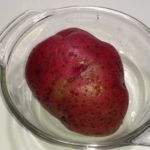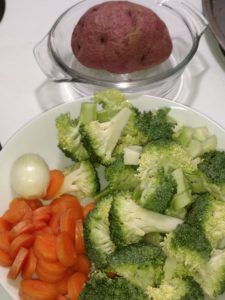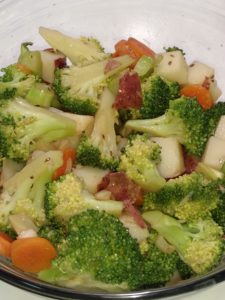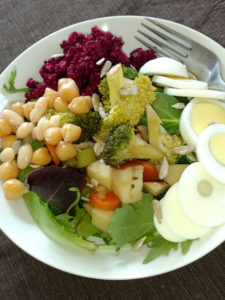Potato-broccoli salad – 18 plant foods!
This is the potato that inspired my salad:
It went in to bake on a Wednesday evening after I’d cleaned up the kitchen from dinner. I wasn’t sure exactly what would happen next, but my plan was to invent a salad that allowed me to consume the potato cold and therefore take advantage of its resistant starch.
I’m eating for microbiome health. Championing plant food diversity. Of course I’d also like my food to taste good, look good, and keep me satisfied from one meal to the next.
I’m playing around with different ways to increase the number and variety of plant foods I consume within any given week. One strategy, since I cook for one, is to make a dish with many ingredients and make enough quantity to have leftovers for a few days.
But I’m also cooking for you. You with a family to serve. A family who probably doesn’t want to eat the same supper four nights in a row. A family with different taste and texture preferences. So I’m also playing around with dishes that have fewer ingredients, that may be finished up in one sitting, that can be combined in different ways.
And let’s get real. It’s mid-week. My weekend food prep items were running low. I needed something to tide me over without running to the store. Something that could be prepped ahead of time and served quickly, since I work right up to mealtime on weekdays.
Enter the potato. Now known as future potato-broccoli salad.
On Thursday after supper, I opened the fridge. What did I have on hand? Some broccoli and a couple of carrots from the supermarket. Small onions and dill seed from the garden. Beets from the farmer’s market. Plus salad greens, eggs, and some pantry items.
First things first. Let’s honor our star, the potato (previously cooked). It was respectfully chunked and placed into a glass mixing bowl. Then I chunked and lightly steamed the carrots and broccoli, minced the onion, and added dill seed, balsamic vinegar, olive oil, and salt. (4 plant foods, not counting dill) Mixed everything up. Potato salad done!
Resistant starch
Let’s have a word about cooked and then cooled potatoes. Since we’re eating for microbiome health, it’s useful to talk briefly about resistant starch. Basically, cooked and then cooled potatoes contain a particular type of starch that escapes digestion in the small intestine, and is instead broken down in the colon. There are some good things about this. They feed the microbiome. Basically they form a substrate that supports certain beneficial bacteria that produce short chain fatty acids (SCFAs), including butyrate — which supports healthy gut tissue.
And since they’re metabolized slowly, they provide a longer-term energy source without raising blood sugar to the same extent as starches that the body consumes in the small intestine. Isn’t that great?
More variety, please. What about those beets?
At this point, I’m aiming to consume 40+ distinct plant foods in any given week. The potato-broccoli salad was cool, but not enough. And I had beets on hand. Beets are rich in polyphenols, those bright colors that also do your gut a world of good.
I quickly recalled a recipe for beet tapenade from one of the specialty cookbooks I picked up a number of years ago: Pestos, Tapenades & Spreads. Its main ingredients are beets, walnuts, balsamic vinegar, olive oil, and salt. (2 plant foods) It’s very easy to prepare, and so I did. Between the beets themselves and the balsamic vinegar, this flavor is a bit sweet. It’s a nice contrast with the potato salad, and so colorful!
Legumes, any one?
Legumes provide additional benefits as a bacterial growth substrate, and I’ve been including them, when possible, every day. The easier-digesting ones, like garbanzo beans, great northern, black beans, maybe a few pintos. Well-cooked, please! I usually prepare mine from dried, and so before turning in for the night, I put equal portions of garbanzo beans and great northern into a pan to soak. (2 plant foods) The next morning, it was really easy to turn the burner on low so they could cook as I went about my weekday morning routine. (If you’re prone to getting distracted, please set a timer!)
Potato-broccoli salad is served!
You can do this part differently. Here’s where I found myself. In the fridge, I had the potato-broccoli salad, beet tapenade, the cooked garbanzo / great northern combo, some salad greens (spring greens mix – 9 plant foods), and hard cooked eggs. I piled greens into a bowl and then added a bit of everything on top. Sprinkled with sunflower seeds for crunch and additional variety (1 plant food). And ta da — lunch! It was colorful and hit the spot for sure. (18 plant foods in total)
For different diners, it would be easy enough to use the two side salads as an accompaniment for a piece of cooked salmon, a chicken breast, or maybe a burger. It could be your main meal for the day, and ready to go in a jiffy. You might even get a high five for creativity, flavor, or presentation.
Take home guidance on the potato-broccoli salad inspiration.
Here’s the thing I hope you’ll take home from my little kitchen adventure. If you don’t have these exact ingredients in your kitchen at any given moment, then use what you have. In place of the broccoli, I could have used cauliflower, green beans, or Brussels sprouts. We could add something or leave something out. Put a little garlic into the dressing. It could really be nearly any combination. For mid-week inspiration, just look in the fridge and use what you have.
References:
Functional Nutrition Consultation:
Get your groove back & bring harmony into your life.
Consider one of our health-building functional nutrition programs.













Leave a Reply